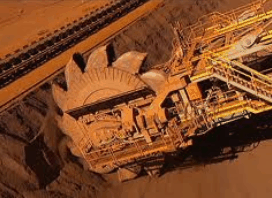
Cross-posted from The Conversation
What are investors who buy BHP Billiton shares buying into? BHP shares are a bet on two things. First, commodity prices and especially the price of iron ore, hydrocarbons and copper. Second, the ability of BHP management to execute their strategy by continually reducing production costs and developing new projects through exploration or judicious acquisitions.
BHP’s annual results say a lot about how these bets are going. Net profit fell to $10.9 billion in the year to June 2013, down nearly 30% from the $15.4 billion of the previous year. BHP reports in US dollars, so all of these figures are in that currency. Sales were down 9% from $72 billion to $66 billion.
The results show what a leveraged bet on commodity prices BHP shares are. A 9% decrease in sales caused a 30% decrease in profit. This leverage is not financial leverage – BHP’s debt at $35 billion is not large compared to its $165 billion (market value) of equity. Instead, the leverage is the operating leverage caused by the high fixed costs (such as mines, railways and ports) that the firm must meet even when commodity prices fall.
BHP reports its sensitivity to individual commodity prices. A $1 per tonne decrease in the price of iron ore decreases net profit by $115 million. For oil the figure is a $45 million profit decrease for a $1 per barrel price decrease. For copper, the figure is $20 million lost profit per 1 cent per pound price decrease.
Iron ore now has a dominant role in BHP’s results. Net profits from the iron ore division are 52% of the total. Iron ore production is 30% of revenue but more than half of profits and has a return on equity approaching 35%.
No wonder iron ore has been singled out (along with coal) for the payment of the mineral resource rent tax (MMRT). BHP paid $200 million in MMRT over the year. The firm also reports that its total payment of taxes and royalties are as large as its net profit — $10.8 billion in profit versus $11.2 billion in total tax and royalty payments around the globe.
BHP’s coal division has fallen on hard times. Price reductions and cost increases have reduced profit to the coal division to little more than $200 million, which is down $1 billion in the last year. There is a lot more global competition in coal production than iron ore production. Coal reserves are more evenly spread around the world and the minimum efficient scale of coal operations is smaller than iron ore operations. Moreover, thermal coal prices are already suffering from shale gas boom in the US.
The contention that BHP will start to scale down its coal business unless it can achieve big reductions in costs looks very real. Last week employees in the car industry elevated job security over demands for wage increases and we should expect to see the same in the coal industry shortly.
Overall BHP appears to have done a good job in driving $2.7 billion of costs out of the business. Moreover, investment has been scaled back considerably. Capital expenditure will peak in 2013/14 at $22 billion and then fall to $16 billion in the following year and go lower still in subsequent years. For many years BHP has emphasised the long-term nature of the resources boom, often describing it as a super-cycle. BHP chief Andrew Mackenzie is less ebullient on this matter than his predecessor, Marius Kloppers. The reduction of spending on new projects demonstrates a less bullish view of commodity prices and volumes.
Under Mackenzie’s new leadership the focus has clearly moved from expansion to cost reduction. Investors will be pleased with this because they are always worried that management will waste their money on projects that look good initially, but deliver low or negative returns in the end. If cash flows hold up above $20 billion per year and capex is wound back, then Mackenzie will come under pressure to return a lot of capital to shareholders over the next few years.
He won’t want to ramp up dividends too quickly for fear of having to cut them later, so he will need to announce big share buy-back plans. That will work for BHP’s foreign investors who can’t fully use the franking credits that go with dividends.
After these results BHP looks well placed but its future profitability depends very heavily on demand in the global steel industry for iron ore and coal and supply in the global energy markets.
Article by Sam Wylie, Principal Fellow at Melbourne Business School

